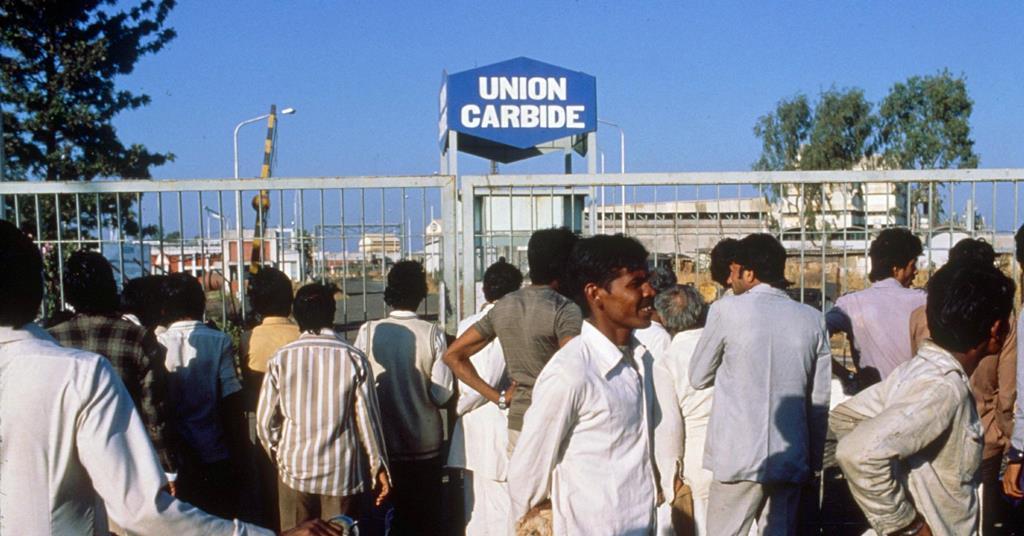
In December 1984, one of the world’s worst industrial disasters hit the city of Bhopal in central India killing thousands and injuring hundreds of thousands. The aftermath of the disaster raised important questions about the value of life in a developing country and the conduct of multinational corporations.
Why are we talking about this now when the disaster was 39 years ago?
A ruling earlier this month by the Indian supreme court has, in effect, ended any chance of victims of the disaster receiving any further compensation.
What was the Bhopal disaster?
On the night of 2–3 December 1984, 40 tonnes of methyl isocyanate gas leaked from the pesticide factory owned by Union Carbide India (UCI) – a subsidiary of US firm Union Carbide – in the city of Bhopal. A dense cloud of methyl isocyanate – a colourless, odourless chemical 500 times more poisonous than hydrogen cyanide – spread over the city, poisoning its populace, damaging eyes and lungs, and disrupting immune, reproductive and musculoskeletal systems. People, birds and animals dropped dead on the streets. Several thousand were estimated to have died in the first three days as doctors struggled to treat those exposed. In the coming months and years, over half a million people suffered chronic long-term effects from methyl isocyanate.
Who was responsible for the disaster?
Writing in the local press two years before the disaster, Rajkumar Keswani reported that safety procedures were lax at the UCI plant, making it a ticking time-bomb. His warnings fell on deaf ears. Following the disaster, both Union Carbide and UCI were accused of cutting corners and installing inadequate and improper safety systems compared with their other plants. UCI and its parent company blamed sabotage for the disaster, but later struck deals out of court with the Indian government.
How many people were affected? How many died?
According to official records, the disaster resulted in the death of 5295 people and injuries to 568,292. The Madhya Pradesh State government’s welfare commissioner listed 15,248 official deaths up to 1997. Survivors’ organisations estimate the death toll to be 22,872 up until 2010. The official figures are hotly contested by survivors’ groups and the disparity is the result of the time period the deaths are counted over and, they claim, arbitrary downgrading of some deaths to injuries. A 2004 study by Amnesty International estimated an immediate death toll of between 7000–10,000.
What compensation was paid out?
In order to provide speedy remuneration to victims, and to create an institutional framework for distribution of compensation, the Indian government passed an act in 1985. This granted the central government exclusive rights to represent and act in place of every person who was entitled to make a claim for compensation. It also empowered the government to institute lawsuits or other proceedings.
The act meant that survivors and their organisations could not sue Union Carbide, making it the responsibility of the government, which demanded $3.3 billion (£2.7 billion) from Union Carbide but settled for $470 million out of court. Survivors’ organisations called it a sell-out and allegations of corruption involving politicians and the judiciary were rife.
According to survivors’ organisations, the average compensation paid out to those with minor injuries was INR50,000 (£494), serious injuries INR52,000 up to a maximum of INR100,000 (£988) and INR200,000 was paid to family for a death.
Organisations representing victims have questioned the criteria used to categorise injuries. They say 6000 people have been visiting various hospitals daily for a variety of serious ailments linked to the disaster for many years.
Was anyone convicted over the disaster?
On 7 December 1984, Warren Anderson, chairman of the Union Carbide was arrested by the Madhya Pradesh police at Bhopal airport as he arrived from the US. He had been charged with ‘culpable homicide not amounting to murder’. However, intense US pressure on Rajiv Gandhi’s government led to Anderson being released on bail. He then fled to the US. Anderson died in 2014 never having been brought to justice.
Twenty-five years later, a local court sentenced several former Union Carbide employees – all Indians – to two-year prison sentences for negligence. These former employees included Keshub Mahindra, the former chairman of UCI, VP Gokhale, managing director and Kishore Kamdar, vice-president. They were ordered to pay a fine of INR100,000. The supreme court amended the charge from ‘culpable homicide’ – that carries a maximum sentence of 10 years – to a ‘rash and negligent act’ in 1996 attracting a two-year prison sentence. Not one of those convicted went to jail, however.
What happened to Union Carbide in India, following the disaster?
Two years after the disaster, UCI was still doing business in India, despite protests by survivors. In December 1987, however, charges were filed against Anderson, Union Carbide and its subsidiaries. This led to Union Carbide and UCI quitting the country, apparently.
Further details emerged from an investigation published by Al Jazeera in December last year that suggest that this isn’t the whole story. The report revealed that front companies were created to continue business as usual. These companies continued to supply Union Carbide products to various Indian government and private entities for close to 14 years. Although records are sketchy, they indicate that between 1995 and 2000, the company sold 55,800 tons of wires and cables on the Indian market, for instance.
Is this the end of the road for Bhopal victims searching for justice?
While the supreme court has effectively closed its doors to victims seeking legal redress from Dow Chemical – the current owners of Union Carbide – the legal cases are not over. Two more cases are still pending in the supreme court: UCI is accused of contaminating groundwater with hazardous waste and local people are suing for the provision of clean drinking water and another is seeking compensation from the Indian government. Several other criminal and medical cases are still pending in local and regional courts.